Perfect Summer Gazpacho
on Jun 24, 2024, Updated Jun 30, 2025
This post may contain affiliate links. Please read our disclosure policy.
How to make the best, most refreshing, and absolutely beautiful soup of summer. With step-by-step instructions and photos.

If you want to taste summertime in a bowl, then look no further than this chilled soup. Gazpacho makes the very most of all of the vegetables that burst onto the scene with a vengeance towards the end of the summer, daring us to find ways to use them up before they either go bad or fade away into the next season. Gazpacho looks those tomatoes and zucchinis and cucumbers and herbs in the eye and says, “Come to me, I will make you into something fabulous.”
While it’s true of many, if not all, dishes, somehow getting the right balance of tart, salt, and pepper seems to be a definitive line between good gazpacho and great gazpacho, so don’t skip the final tasting and adjusting. You don’t need to do anything to this wonderful summer soup, but a drizzle of olive oil, some lime wedges, and a few chunks of avocado never make anything worse.
By signing up, you agree to our Privacy Policy.
Summer recipes go well with other summer recipes! I like serving gazpacho to kick off a meal featuring something grilled, like Chicken Kabobs with Vegetables or, if I’m feeling lavish, Grilled Lobster Tail. Finish the meal with a Simple Peach Crisp for the perfect end-of-summer meal.
What's In This Post?

What Is Gazpacho?
Gazpacho is a cold, raw, blended vegetable soup, often made with tomatoes. It hails from Spain and is also very popular in Portugal. While some traditionalists mince everything by hand, if you have a food processor or a blender, you are well on your way. Tomatoes are usually the star of this soup, regularly accompanied by cucumbers, something from the onion family, and maybe some herbs.
A bit of something acidic (most traditionally vinegar — sherry vinegar, in particular), maybe some peppers (possibly sweet and hot together), and some olive oil for smoothness and overall flavor and deliciousness balance out the cold soup. After that, there is much open to interpretation (or maybe not much — it depends on how devoted you are to tradition).
Gazpacho Variations
There is discussion about whether or not to add tomato juice, or water, or just to let the juices of the tomatoes and vegetables pull it together. There is also discussion about how smooth or chunky gazpacho should be, and how thin or thick it should be. And there is even discussion about whether or not to add stale bread, whether almonds should be included, and whether to use a blender, a food processor, or chop by hand.
In short, as with any traditional/beloved/classic dish, there is a lot of discussion. I am of the mind that there is more than one way to do almost everything, so you can take this basic template for what it’s worth and layer on your own opinions!
Ingredients

- Shallot and red onion– You’re going to roughly chop your shallots and onions, which will then get more finely chopped in the food processor.
- Cucumber – Seedless cucumber is best for gazpacho. If your cucumber has lots of seeds, cut it lengthwise and scrape them out with a spoon.
- Fennel – Trim off the fronds, remove the core of the bulb, and then get to chopping it up into smaller pieces.
- Hot pepper – Don’t go too spicy unless you’re aiming for a spicy soup! See if you can find a mild or medium Hatch pepper (available at the end of the summer). If you can’t get your hands on one, then you can sub a jalapeño. You’ll seed the pepper to remove most of the heat either way.
- Plum tomatoes – Or use whatever meaty ripe tomatoes you have — the only key is that they have to be ripe.
- White bread – Slightly dry white bread, with the crust trimmed and ripped into chunks, helps thicken the soup and gives it a bit of body. You won’t even know it’s there once it’s blended. Skip it if there are gluten allergies in your world.
- Zucchini and red bell pepper – Dice up your zucchini and pepper very finely so the vegetables blend into the soup, or just cut them into chunks and give them a pulse in the food processor.
- Tomato or vegetable juice – I actually love using V-8 juice in my gazpacho.
- Extra-virgin olive oil – Break out the good stuff for this recipe, plus extra for drizzling.
- Sherry vinegar – Sherry vinegar is important, adding an acidic zing to your gazpacho. Red wine vinegar is a fine substitute.
How to Make Gazpacho
- Roughly chop the vegetables: This makes it easier for the food processor to finely chop them without leaving any big chunks.

- Finely chop and dice the vegetables: I like to pulse most of them in a food processor with the metal blade to get them nice and finely chopped, but dice a couple of the vegetables for a contrasting texture.

- Chop the tomatoes and bread: Add the torn bread and mix it into the tomato base. You don’t want to let the motor run when making gazpacho, especially not here, so the bread doesn’t turn into paste. Pulse away.

- Accumulate veggies: As you pulse or chop the vegetables in batches, add them to one big bowl where they will become your lovely soup.

- Add some contrasting texture: I usually like to dice a couple of the vegetables so they have a little bit more shape. This adds some nice textural contrast to the gazpacho.
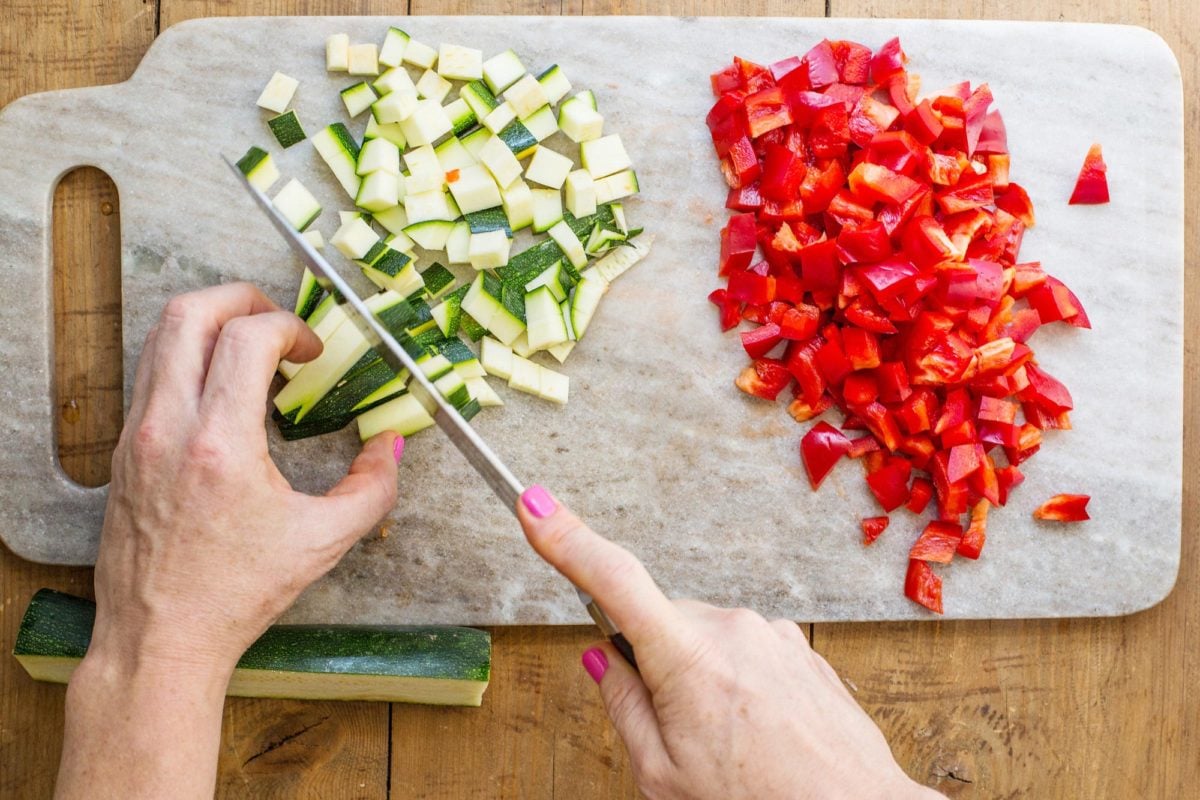
- Stir in the liquid: Some people prefer to just let the natural juices of the vegetables mingle with some olive oil, a bit of acid (such as vinegar), and possibly water. I like to add a bit of tomato or vegetable juice to help pull it all together. I also like to pull the mixture together by taking a cup or two of the chopped vegetables and pureeing them with some juice to create a thick puree. Then, stir that back into the gazpacho and add the seasonings.

- Garnish: Top with a drizzle of olive oil and some diced avocados if you like.

What to Serve With Gazpacho
Pin this now to find it later
Pin It
Perfect Summer Gazpacho
Equipment
Ingredients
- 2 shallots (roughly chopped)
- 1 red onion (peeled and roughly chopped)
- 1 large seedless cucumber (cut into chunks)
- 1 medium bulb fennel (trimmed, cored and cut into 1-inch pieces)
- 1 stemmed, seeded, and chopped mild Hatch pepper (or 1 stemmed, seeded and chopped jalapeno)
- 8 large plum tomatoes (cored, seeded and cut into 1-inch pieces)
- 2 thin slices slightly dry white bread (crust trimmed, ripped into chunks)
- 1 zucchini (diced small)
- 1 teaspoon red bell pepper (cored, seeded, and diced small)
- 3 cups tomato or vegetable juice such as V-8
- 3 tablespoons extra virgin olive oil (break out the good stuff for this recipe, plus extra for drizzling)
- 2 tablespoons sherry vinegar
- Kosher salt and freshly ground black pepper to taste
- Diced avocado and lime wedges to serve (optional)
Instructions
- In the bowl of a food processor or in a blender, combine the shallots with the onion, and pulse until finely chopped, but do NOT puree! Turn into a bowl. Place the cucumber, fennel, and hot pepper into the food processor and do the same, then add those to the onion mixture.
- Add half of the tomatoes with one slice of the bread, pulse, and turn those into the bowl as well. Finally, pulse the rest of the tomatoes with the remaining slice of bread, add them to the lot, and stir to mix.
- Scoop one cup of the vegetable mixture back into the food processor, then add the tomato juice, olive oil, and vinegar and season with salt and pepper. Puree the mixture, then add it to the bowl, along with the diced zucchini and bell pepper, and stir to mix.
- Check the seasonings. Chill the soup for at least 3 hours, and up to 2 days (the longer you let it sit in the fridge, the more the flavors meld), and serve quite cold. Stir well before serving, adjust the seasonings as needed, and pass the diced avocado and lime wedges on the side if desired. You may also want to give the portions a final drizzle of extra-virgin olive oil.
Notes
Tips
- The order in which the ingredients are pulsed does not matter; just make sure you pulse the minced jalapeño with at least one of the cubed vegetables so it all incorporates nicely. You can pulse the vegetables coarsely or until they are pretty finely ground, and you can add more or less tomato juice as you please — gazpacho is a very personal balance between flavor and texture.
- Also, if you want to skip any of the vegetables (other than the tomatoes — that would be silly), that’s fine.
- The tiny bit of sugar just brings out the natural sweetness of the tomatoes and balances the slight bitterness of some of the other vegetables.
- Adding a torn-up slice or two of bread to the mix will thicken the gazpacho and add body. Use a simple white bread so it doesn’t interfere with the clean flavors of the vegetables. Use gluten-free bread if gluten is a concern.
- If you want your gazpacho to have a chunky texture, don’t let the motor run in the food processor. Pulse everything so your veggies get chopped, but you can control the texture. If you like a smooth texture, then yes, let it run!
- You can certainly pulse all of the vegetables in the food processor instead of cutting any of them by hand, and get a great gazpacho. And you can certainly dice all of the vegetables by hand if you want a more uniform, fancy-looking gazpacho. That takes a lot of time, though, so one compromise (that I love) is to dice one or two of the vegetables, especially vegetables that are easy to neatly dice, such as this zucchini and bell pepper.
- As for the tomatoes, to peel or not to peel? This is a question that I usually answer with “nah.” I do make sure to cut out the tough stems and cores, then cut the tomatoes into chunks before roughly chopping them in the food processor.
- Note that the food processor does not get cleaned out in between vegetables — they all end up in the same bowl!
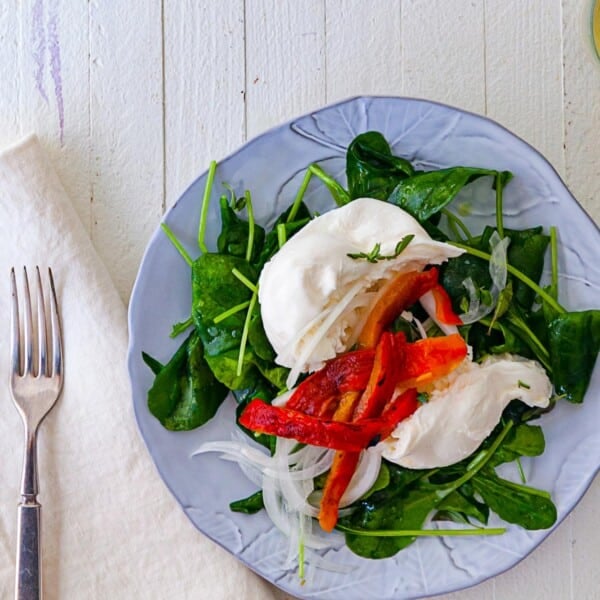
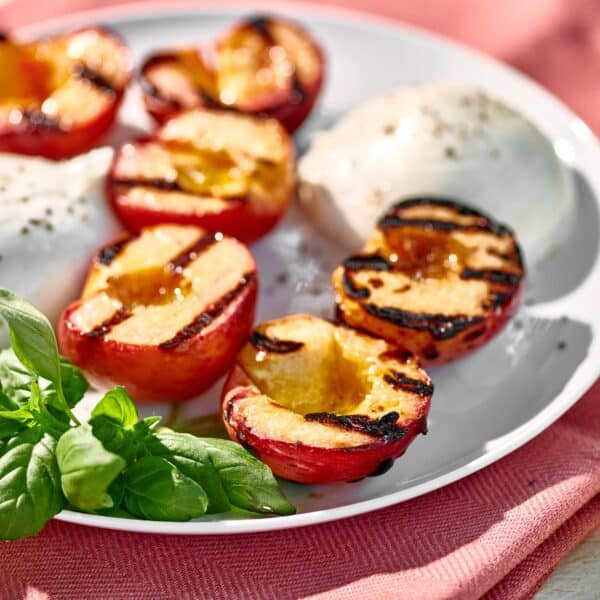
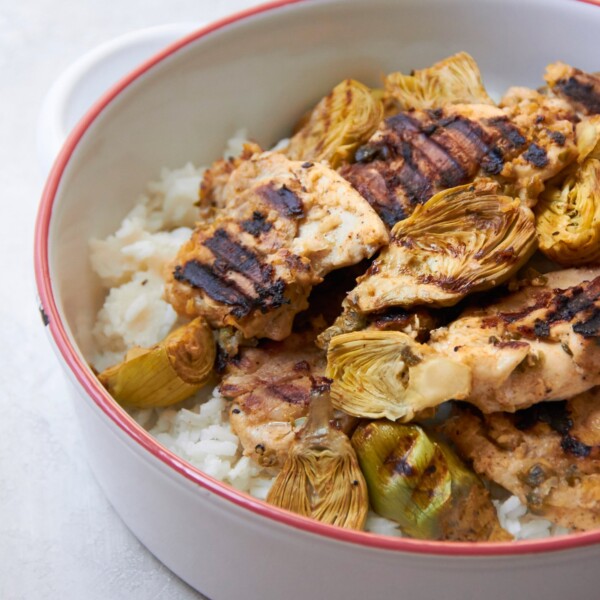
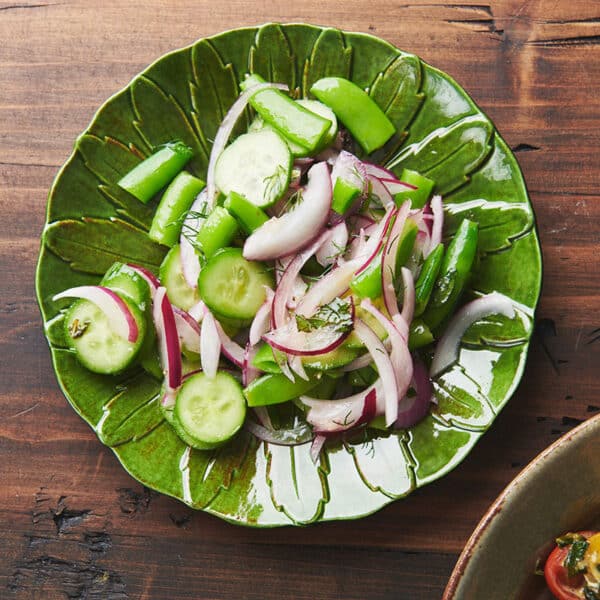
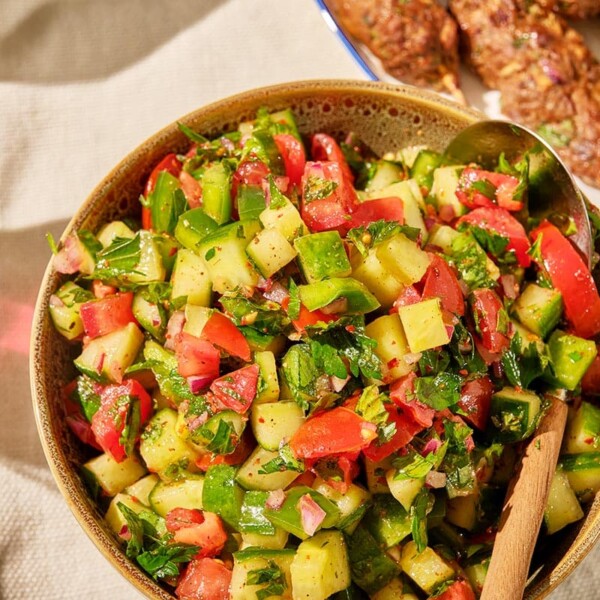
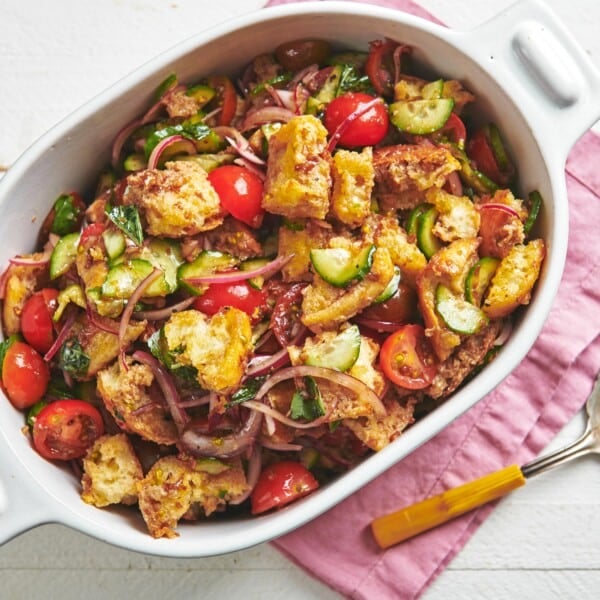
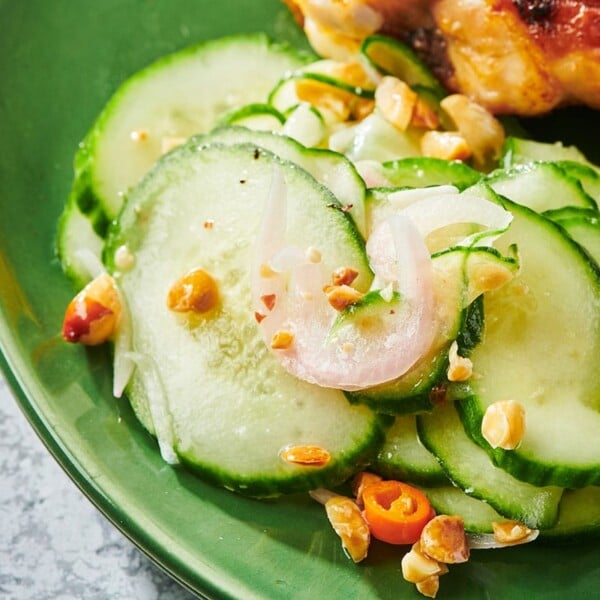









Absolutely perfect!